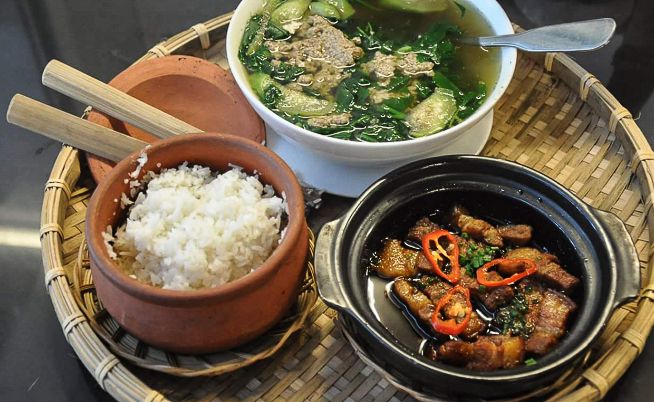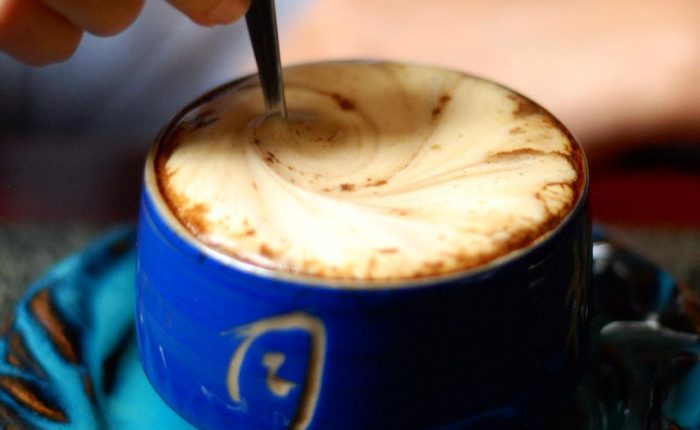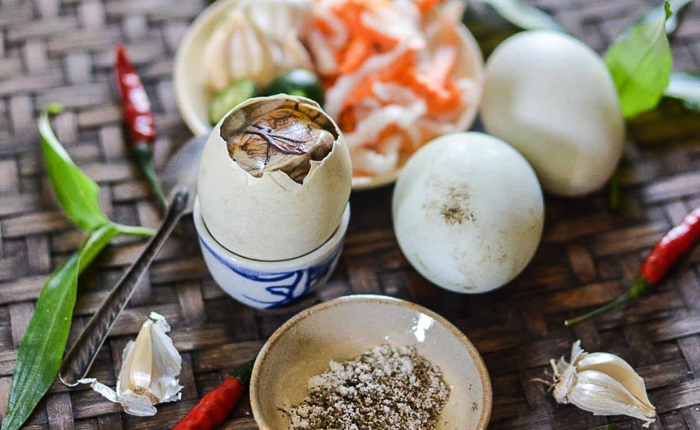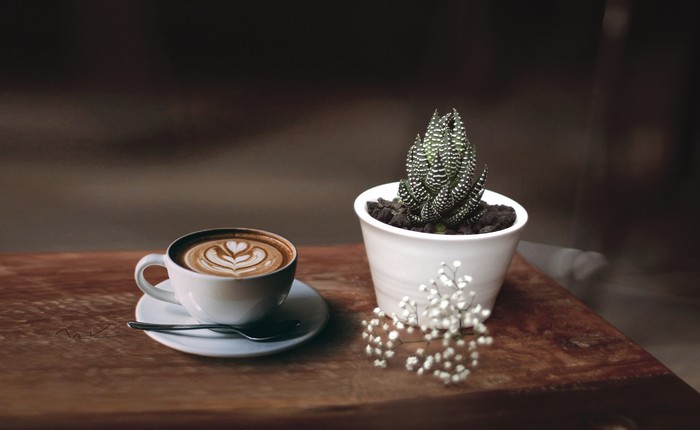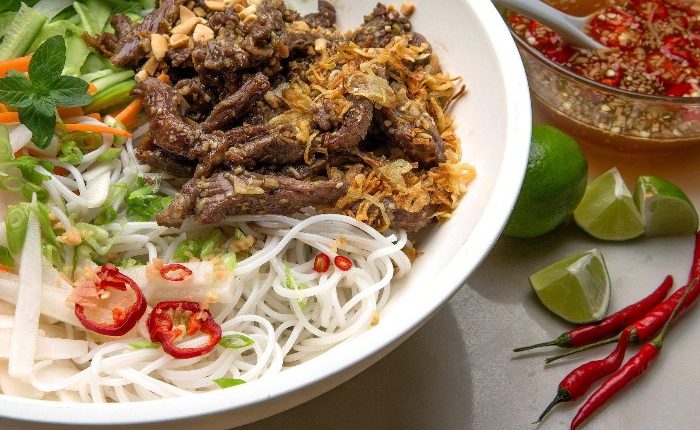Sure, you have heard of banh mi, pho or bun as Vietnamese signature street foods. They are, however, for the most part, salty and savoury dishes. Vietnamese has mastered the craft of street foods with their sweet desserts in addition. Be it cakes, pies, soup or snacking candies, they will all leave you craving for more.
Despite the constant wave of foreign foods coming in, traditional Vietnamese desserts always have a special place in their heart, remaining popular among both the old and the young generations no matter what. Get your snorkel and dive in with us to see the must-eat desserts of Vietnam.
Cake and Pie
Savoury salted egg pound cake (Bánh bông lan trứng muối)
Who said desserts are supposed to be sweet? This savoury pound cake that originated from Vung Tau 40 years ago was first made by a lady selling pound cakes under the electric pole. The saltiness of the salted egg and meat floss blends with the sweetness of the egg oil sauce and the pound cake, leaving a savoury and creamy taste in your mouth. The cake is a big hit and is especially popular among the youth today as the Vietnamese come up with new recipes after recipes to spice things up. From adding cream cheese, to changing up the sauce and different cake shapes and forms.
Hanoi – Bong lan trung muoi Kieu Anh
- Address: 61 Tran Nhan Tong Str.
- Price range: 20,000 – 100,000 VND (0.9 – 4.3 USD)
- Opening hours: 10 am to 9 pm

Ho Chi Minh City – Banh bong lan trung muoi Calicious
- Address: 34/1 Le Binh Str., Tan Binh Dist.
- Price range: 35,000 – 220,000 VND (1.5 – 9.5 USD)
- Opening hours: 9 am to 3:30 pm

Bánh pía
Do you like durian? Even if you don’t, why not try a subtler version of durian in banh pia? It is a Soc Trang’s speciality, which is a Vietnamese take on Chaozhou’s mooncake when some of the Chinese moved to Southern Vietnam. The typical version of this dessert is stuffed with durian, mung bean and the salted egg(s). However, as it gained a reputation, Vietnamese have created different versions for different preferences such as using taro, coconut, shredded pork fat, or even fruits such as mango and lemon! People say that you either fall deeply in love or absolutely loathe durians. If you are a first-timer, take a bite of banh pia to start your love (hate) story with durian!
You can buy this Vietnamese dessert anywhere, from supermarkets to local shops, or even online. Take a look at some of our suggestions!
Banh Pia Tan Hue Vien
- Price range: 50,000 – 160,000 VND (2.2 – 6.9 USD)

Banh Pia Bao Minh
- Price range: 45,000 – 200,000 VND (1.9 – 8.6 USD)

Mung Bean Cake (Bánh đậu xanh)
This dessert stands pretty high on the list of souvenirs foreigners often bring back home, or as presents that Vietnamese people bring abroad. These mushy chalky mung bean cubes may taste confusing to a lot of people. However, when served with tea, they become the golden star of the party. Mung bean cakes now come in more variety of flavours such as durian (you need ‘em), taro, matcha, etc. Pick your fave, grab a few friends and have a Vietnamese style tea party with Vietnamese desserts.
Once again, you can buy them anywhere in Vietnam. Some of the more popular brands are:
Banh dau xanh Rong Vang Ky Anh
- Price range: 30,000 – 160,000 VND (1.3 – 6.9 USD)

Banh dau xanh Nguyen Huong
- Price range: 45,000 – 225,000 VND (1.9 – 9.7 USD)

Banh dau xanh Rong Vang Minh Ngoc
- Price range: 25,000 – 150,000 VND (1.1 – 6.5 USD)

Bánh cốm
Like how the Japanese put Anko (red bean paste) in anything and everything, mung beans are in the genes of the Vietnamese. Banh com utilizes cốm- roasted immature rice kernels, which produce the natural green colour, and is filled with yellow mung bean. This glutinous cake is square-shaped and packed nicely in a box.
These small Vietnamese dessert bites used to be a luxury; hence, only the rich in the village could afford them. Therefore, they started to bring this little cake as part of the offerings to the in-laws (on the ladies’ side) at the engagement ceremony. Years after years, banh com became more affordable and a traditional offering at engagement ceremonies in the North.
Hanoi – Nguyen Ninh
- Address: 11, Hang Than Str.
- Price range: 5,000 VND (0.2 USD)
- Opening hours: 7 am to 9 pm

Bánh da lợn (Steamed Layer Cake)
The name “Bánh da lợn” literally translates to pigskin cake. Worry not because it is not actually pigskin. The cake is actually made from tapioca starch, rice flour, coconut shreds, vanilla and coconut leaves, filled with mung bean, mashed taro and durian and layered beautifully. After getting steamed, its gelatinous texture is like that of a pig’s skin, inspiring its rather misleading name. Its lightly sweet taste and thick jelly-like consistency make it ideal to be the after-meal dessert.
Hanoi – Banh Da Lon Nguyen Kim
- Address: 36/3 Cau Buou
- Price range: 55,000 – 125,000 VND (2.4 – 5.4 USD)
- Opening hours: 7 am to 8 pm

Ho Chi Minh City – COCOCake
- Address: 279/22, Huynh Van Banh Str., Phu Nhuan Dist.
- Price range: 55,000 – 125,000 VND (2.4 – 5.4 USD)
- Opening hours: 7 am to 8 pm

All things fried
It would be a bummer if Vietnamese streets lacked fried/grilled foods that you can hold, eat and walk while windowshopping. Aside from meat skewers and hot dogs, street food stalls also offer sweeter, fruitier and doughier versions of fried/grilled foods. Check out these must-eat Vietnamese desserts on the streets:
Bánh rán (Bánh cam)/ Bánh còng/ Bánh tiêu

This is the Vietnamese version of a doughnut. While banh ran (banh cam) is shaped like a little ball of sesame or sugar, banh cong looks like your regular donut, and banh tieu is the deflated version of banh ran. They could have no fillers, or are filled with mung bean. Another thing to note about the differences between them is that banh tieu is relatively less sweet than the other two due to their sweet saucy coat.

Bánh chiên
Walk on Vietnamese streets often, and you may spot one or two street vendors selling long fried dough. Usually, they are a banana, corn, or sweet potato mashed, covered in flour batch and fried. These steamy sweet crunchy goodness usually do not have any additional sugar; hence, the mild sweetness is pure natural. These will be a good choice on those cold winter days when you need to snack on something warm and filling. What’s great is that they are so easy to make that you can even do it on your own at home!

Since these are common street foods, you may catch sight of them in the crowded walking streets, the Old Quarter or just randomly on the street and any local Vietnamese market. Keep an eye out!
Honey, where is my souper soup?
Sweet soup (Chè)
Chè is a popular Vietnamese dessert soup that originated in China. It is a combination of beans, fruits, jelly, tapioca, seeds, leaves and anything that you can imagine to be cooked long enough to become a bowl of sweet soup.
Chèck out some of the most popular types:
Mixed sweet soup (Chè thập cẩm)
Do you notice how people can put almost anything in an Asian hotpot? This is the hotpot of chè. Various types of beans are mixed with colourful jellies and starchy potatoes, which is then finished with a dash of coconut milk, coconut shreds and a large spoonful of little ice cubes. This is perfect for when you do not know which type of chè to choose since you’ve got everything in your little glass.
In addition, the ingredients also vary between regions. Hence, if you are a fan, why not grab a glass every time you arrive at a new destination?

Sweet black beans/red beans soup (Chè đỗ đen/đậu đỏ)
Generally speaking, chè is very easy to eat for its sweet and refreshing taste. However, if you are still having doubts due to whatever reason, chèck this starter flavour! Cooked black (or red) beans, black jellies and ice always rub you in the right spot when you crave some chè. One thing for sure is that its simplicity is both delicate and thirst-quenching despite not using any out-of-this-world ingredients or cooking techniques.

Sweet mung bean soup with coconut milk (Chè đỗ xanh nước cốt dừa)
Remember Vietnamese’s “obsession” with mung bean? Well, they would not be incorporating it into their cuisines so much were it to taste bad. Not only in the main courses, salty and savoury dishes, but mung beans are also widely used in Vietnamese desserts as well. Similar to the sweet black/red beans soup, Vietnamese people go easy on mung beans, yet are still able to give it a delightful taste. The mild sweetness is definitely elevated by the finishing touch of the coconut milk. Yum!

Sweet corn soup (Chè ngô)
This dish of chè will no doubt a-maize you! The sweet corn, the distant smell of grapefruit essence, the nutty taste of roasted sesame seeds will pop(corn) your tastebuds. Try to corn-trol yourself when corn-suming. Also, remember to share this info with your friends and families since it is no corn-fidential information. Too corny?

Khuc Bach Sweet Gruel (Chè khúc bạch)
Khuc Bach Sweet Gruel is more of a jelly dessert, rather than the usual cooked sweet soup that you have seen so far. No one is exactly sure where it came from. Some say it is the Vietnamese take of Hongkong’s tofu dish. Some, however, think that it was from when the French came. The name “Khuc Bach” means “little white cubes”, indicating the main star of this dessert, which is what it consists of originally. These days Vietnamese are getting more creative with the dish and incorporate numerous other ingredients to create a colourful bowl of sweet gruel, instead of just pure white. For example, chocolate is added for the brown colour; matcha for the green; strawberry for the pink; etc.

Lotus seed and longan sweet soup (Chè sen long nhãn)
This dessert tastes and looks like a high-class delicacy, which is not wrong. One has to pick the freshest lotus seeds of the bunch, wash them and take out the bitter centre, leaving only the refreshing mild sweetness. Longans are also freshly prepared, the seeds of which will be carefully picked out so as not to ruin the fruit’s round shape. After cooking the lotus seeds with sugar water, they will slip into the longan coat delicately.

Chè Bà Ba (Chè Thưng)
Chè Bà Ba is a popular dessert in Southern Vietnam. Bà Ba, the woman who is said to be the creator, added 9 – 10 completely new ingredients to the traditional chè dish, such as seaweed, cat ear mushroom, etc. Chè Bà Ba reflects the beauty of a Southern Vietnamese lady, modest, homely yet extremely attractive.

☕ Did you know? “Nước chè” is also often used to refer to tea in the North (commonly known as “trà”); therefore, do pay attention so as not to mix up the two.
Violet glutinous rice yoghurt (Sữa chua nếp cẩm)
Or violet rice yoghurt! The vivid purple colour of the rice is the sweet shining star in the middle of the yoghurt bowl. In addition to the commonly known health benefit of yoghurt to our digestive system, the violet glutinous rice is also full of nutrition and vitamins. Who would turn down a tasty healthy bite?

Flan (Caramen)
Why “caramen” you ask? The original word was probably “caramel”, which is the brown sugar substance often used in desserts and Asian cuisines. When used in Vietnamese language, people naturally rewrite it as “caramen”. Other than eating this dessert on its own, Vietnamese also put it in yoghurt or milk, mixed with other jellies and beans, similar to the mixed sweet soup. An interesting boost of texture, taste and colours will be a fun afternoon treat on your adventure!

Douhua (Tào phớ)
After having this, you will no longer think bad of tofu. This is easily everyone’s favourite, from children to the elderly. The tender slices of tofu dipped in sugar water will quench your thirst, stimulate your neurons, tickle your t(à)oes, fix your phớ-rown, crush your soul and solve world hunger. Truth.

You can enjoy all of the soupy goodness at the below addresses:
Hanoi – Che 4 mua
- Address: 4 Hang Can Str., Hoan Kiem Dist.
- Price range: 15,000 – 22,000 VND (0.6 – 0.9 USD)
- Opening hours: 9 am to 10 pm

Ho Chi Minh City – Che Mam Khanh Vy
- Address: 242B Su Van Hanh Str., District 10
- Price range: 5,000 – 30,000 VND (0.2 – 1.3 USD)
- Opening hours: 5 pm to 10:30 pm

Bánh trôi – Bánh chay
These round balls dessert came from China. There is actually a day dedicated to these two dishes in Northern Vietnam, the 3rd of March in Lunar Calendar, the Cold Food Festival. Bánh trôi chewy sticky white balls are stuffed with brown sugar cubes and sprinkled with sesame seeds on top. On the other hand, mung-bean-stuffed bánh chay swims in thick sugar water.


Hanoi – Quan Che Muoi Sau
- Address: 16 Ngo Thi Nham Str.
- Price range: 15,000 – 20,000 VND (0.6 – 0.9 USD)
- Opening hours: 7 am to 6:30 pm
Who screamed? Ice cream!
No one is not a fan of ice cream. Having a stick or a cone of ice cream after dinner and enjoying the streetlife on a hot summer night is one of those memorable moments that just stick to the back of your head.
However, if you prefer hanging around at the shop to take-out, numerous vendors and shops do have beautiful decorations, instagrammable plating and entertainment to fill your needs. Check out some of our top recommendations:
Trang Tien Ice cream
Trang Tien Ice cream is one of the must-try desserts when in Hanoi. It has almost become a common practice among the Vietnamese to grab a stick/cone of Trang Tien ice cream when you are walking around Hoan Kiem Lake, especially on weekend nights. Some even said, “You won’t become a legit Hanoian until you try Trang Tien Ice cream”.
The brand produces a wide range of flavours, within which Cốm has stood out as the most popular. This is possibly due to the fact that Cốm is one of Hanoi’s specialities as aforementioned in Bánh cốm.

Other than single instant servings of ice cream, they also sell boxes to bring home as well.
There is, however, a lingering problem regarding the authenticity of certain Trang Tien Ice Cream shop. Due to its popularity, quite a few fake brands have tried to imitate and use their logo to deceive consumers.
- Address: 35 Trang Tien Str., Hanoi
- Price range: 8,000 – 45,000 VND (0.3 – 1.9 USD)
- Opening hours: 8 am to 10 pm

Hoian Tube Ice cream (Kem ống Hội An)
These ice cream sticks taste as interesting as they look! From the mold to the way the shopkeeper makes, it looks as if they were drawing a sword. These small and cheap ice cream stick moving vendors have become an intriguing part of Hoian Ancient Town and Hanoi’s Hoan Kiem Walking Street. Saw a colourful steel roller crowded with people? Then you may encounter one!
- Address: Hoian Ancient Town/ Hoan Kiem Walking Street
- Price range: 5,000 – 10,000 VND (0.2 – 0.4 USD)

Other brands
Ralf’s Artisan Gelato
- Address: 39 Dang Thi Nhu Str., District 1, Ho Chi Minh City
- Price range: 70,000 – 400,000 VND (3 – 17.2 USD)
- Opening hours: 1 pm to 10 pm
Fanny
- Address: 29 – 31 Ton That Thiep Str., District 1, Ho Chi Minh City/ 51 Ly Thuong Kiet, Hoan Kiem Dist., Hanoi
- Price range: 50,000 – 350,000 VND (2.2 – 15.1 USD)
- Opening hours: 8.30 am to 11 pm
Osterberg Ice Cream
- Address: 94 Xuan Thuy Str., District 2, Ho Chi Minh City
- Price range: 50,000 – 140,000 VND (2.2 – 6 USD)
- Opening hours: Mon – Fri: 12 pm to 10 pm/ Sat – Sun: 10 am to 10 pm
Gelato Italia
- Address: 31 To Ngoc Van Str., Hanoi
- Price range: 30,000 – 200,000 VND (1.3 – 8.6 USD)
- Opening hours: 10 am to 10 pm
Candies
Salted/Sugared dry fruit (Ô mai)
O mai! Have you seen these before? It is a common souvenir that Vietnamese people bring with them when going abroad. Additionally, it appears in almost every family’s bowl of treats during Lunar New Year.
Colourful pieces of fruit are dried, coated and stir-fried in sugar/salt to bring the iconic sweet and sour taste. Aside from the role of a good dessert treat, o mai also works undercover in the medical field thanks to its medicinal effect on throats and common colds.
If you are unfamiliar with it, it is better to start with less hardcore fruits such as apricots before trying the soul-scratcher sour lemons.
Take a look at the following brands and you can grab them at their physical shop, website or any supermarket. They work great as souvenirs!
O mai Hong Lam
- Price range: 50,000 – 500,000 VND (2.2 – 21.5 USD)

O mai Van Loi
- Price range: 70,000 – 100,000 VND (3 – 4.3 USD)

Peanut candy (Kẹo lạc)/ Peanut and sesame candy (Mè xửng)
These taste so good you’ll go nuts! Squares of peanuts and sesame are as nutty as they can get! When translated to English, they do not seem that different from each other. The truth is, while kẹo lạc is hard rock, mè xửng is more on the chewy and sticky side (and to the side of your mouth and teeth).


From our research, no Keo lac (Peanut candy) producers really stood out. Therefore, you can grab any at your local supermarket or online. In terms of Me xung (Peanut and Sesame Candy), try the following brands:
Me xung Thien Huong
- Address: Hanoi, Hue, Ho Chi Minh City
- Price range: 10,000 – 60,000 VND (0.4 – 2.6 USD)
- Opening hours:
Sticky rice saves lives
Sticky rice and Sweet soup (Xôi chè)
Sticky rice dipped in sweet soup. Who would have thought, right? The chewy rice and lightly sweet soup complement each other, taking both dishes up a notch.
Hanoi – Xoi Che Ba Thin
- Address: 1 Bat Dan Str., Hoan Kiem Dist.
- Price range: 15,000 – 25,000 VND (0.6 – 1.1 USD)
- Opening hours: 7:30 am to 11 pm

Ho Chi Minh City – Xoi Che Cuc Thi – Quang Trung
- Address: 3 Quang Trung Str., Go Vap Dist.
- Price range: 20,000 – 100,000 VND (0.9 – 4.3 USD)
- Opening hours: 9 am to 10 pm
Ice cream and Sticky rice (Kem xôi)
Similar to xoi che, sticky rice and ice cream is the colder and less shapeless version. This interesting combination is suitable for when you want a light bite yet still filling, especially in the summer.
Hanoi – Kem Xoi Hai Ba Trung
- Address: 8 Hai Ba Trung Str., Hoan Kiem Dist.
- Price range: 10,000 – 22,000 VND (0.4 – 0.9 USD)
- Opening hours: 7 am to 10 pm

Ho Chi Minh City – Kem Xoi Dua Bu Bu
- Address: 205 Duong So 17, District 7
- Price range: 10,000 – 20,000 VND (0.4 – 0.8 USD)
- Opening hours: 3:30 pm to 10:30 pm

Coconut Sticky Rice (Xôi dừa)
The crunchy thin slices of coconut sweeten the white sticky rice while covering it in a coconut aroma. Sprinkle on some peanuts and your Vietnamese dessert is served.
Hanoi – Xoi Dua Via He Ngo Van So
- Address: 22A Ngo Van So Str., Hai Ba Trung Dist.
- Price range: 10,000 – 20,000 VND (0.4 – 0.8 USD)
- Opening hours: Morning


